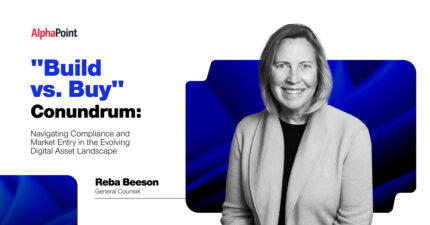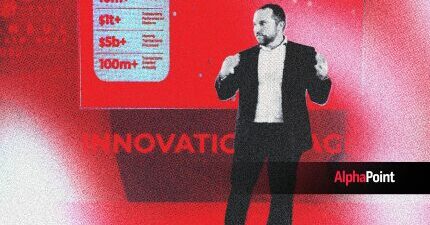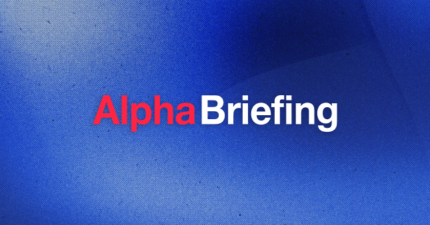The Rise of Real-World Assets (RWAs) in DeFi: Key Players and Opportunities
The financial technology (FinTech) industry is rapidly expanding to attract traditional investors into tokenization, digital assets, and cryptocurrencies. BlackRock, a leading investment firm, has announced its plans to start a real-world asset tokenization fund on the Ethereum network.
This announcement confirms the growing trend of traditional financial institutions embracing the tokenization of real-world assets (RWAs) to lure investors who want to diversify their portfolios.
If you want to integrate tokenized assets into your customer offerings, consider AlphaPoint.
As a leading FinTech company, AlphaPoint provides secure and centralized access to these decentralized assets through seamless integrations and a regulated, managed custodial structure.
But first, what are RWAs, and why are they important in today’s global commerce industry? This guide will explain everything you need to know about their use and wide acceptance.
What Are Real-World Assets (RWAs)?
A RWA is any asset that has real-world value. Generally speaking, an RWA derives its value outside of a blockchain network. These versatile assets can be digital, physical, and data-based.
Some examples of RWAs include:
- Real estate
- Art and collectibles
- Treasury bonds
- Intellectual property (IP) like music
- Tokenized securities
- Traditional financial assets
- Fixed income products
RWAs are created using a process called tokenization. Tokenization involves assigning a token to tangible assets, such as real estate and artwork, and creating a digital twin or copy of that original asset.
This process takes place over an asset tokenization platform.
Through tokenization, digital asset managers can enable fractional ownership. For example, instead of one person buying a building for $1 million, several people can purchase tokenized shares of the real estate worth $100 each. Investors can then buy and sell these tokens, allowing them to invest in real estate with smaller amounts of capital — and without the challenges typically associated with real estate investment.
The most original format of RWAs belongs to stablecoins. Stablecoins are tied to fiat currency, like the Euro or U.S. dollar. Ultimately, stablecoins provide investors with a safer alternative to diversify their portfolios, especially if they don’t prefer to engage with the volatile crypto market.
RWAs vs. Digital Assets
The main difference between RWAs and digital assets is how their value is derived. Digital assets, like cryptocurrencies, are determined by the forces within the crypto market.
For example, bitcoin (BTC) prices fluctuate constantly due to supply and demand dynamics, government regulations, and investor sentiments. Bitcoin is also a deflationary asset, with only 21 million coins circulating.
On the other hand, tokenized real-world assets have a more tangible value in traditional financial ecosystems. Real estate, precious metals, music licensing, and raw materials have values closely tied to tangible commodities. Many RWAs, like gold, are liquid assets that can be converted to cash quickly.
How Do Real-World Assets Get Tokenized on the Blockchain?
Tokenization is a secure and thorough process that involves a wide range of RWAs, from real estate to pieces of code. Here’s a closer look at the tokenization process in detail:
- Asset identification: First, you must decide what asset you want to tokenize by determining its value. RWAs can range from artwork to stocks.
- Selecting a platform: An asset tokenization platform will execute the protocols to create RWA tokens. Most asset managers choose Ethereum because of its easy integration with smart contracts and dedicated developer community.
- Developing smart contracts: Smart contracts are autonomous programs that define how tokens will be created and traded. Because smart contracts don’t involve any intermediaries, they ensure every transaction is efficient, secure, and transparent.
- Token creation: During this process, developers integrate security tokens (STs) with RWAs representing a small fraction of their value. Ethereum developers handle this integration through the ERC-1400 standard and a host of others.
- Token issuance: Once the tokens are created, they’re promoted during a Security Token Offering (STO). This ensures that committed investors can purchase a small quantity of the RWA tokens, streamline project fundraising, and pursue a launch on an exchange.
Using an asset digitization platform takes a lot of manual work out of tokenization. Nonetheless, choosing the right software is pivotal to the success of a tokenization project.
The Potential of RWAs
RWAs present the opportunity to bridge the gap between traditional and decentralized finance (DeFi). In previous years, digital asset managers could only offer cryptocurrencies and NFTs. While very popular, these assets may not appeal to traditional investors who value long-term financial security.
The rise of RWAs opens the door for traditional investors to engage in modern FinTech solutions to complete transactions. This paradigm shift could eventually lead to the marriage of traditional and digital finance.
How Are Real-World Assets Used in Decentralized Finance (DeFi)?
Through tokenization, RWAs have viable use cases in various service offerings and global financial market opportunities. Let’s cover some of these use cases below:
Tokenization
RWAs like real estate, commodities, artwork, and invoices can be tokenized into digital assets on a blockchain. This process involves creating digital tokens representing ownership or a stake in an underlying real-world asset.
This allows investors to buy small stakes into a single RWA. With tokenization, investors can buy stakes in arts and collectibles, which was impossible through traditional investment methods.
Collateralization for Loans
Borrowers can rely on RWAs as collateral to secure loans. Unlike traditional unsecured or cryptocurrency-based loans, using RWAs as collateral can provide lenders with more tangible security.
Because some RWAs are more stable than cryptocurrencies, lenders could lower interest rates and increase borrowing limits because they will have tangible collateral at their disposal.
Yield Farming and Earning Interest
RWAs don’t just benefit DeFi organizations. Token owners can also take advantage of yield farming to earn interest through DeFi protocols.
For example, by contributing tokenized real estate to a liquidity pool, investors can earn yield through transaction fees or interest. This situation creates a win-win solution for exchanges that need liquidity and investors who can provide it in exchange for interest rewards.
Enhanced Liquidity
Tokenized RWAs can be fractionally owned. This means that investors can buy and sell fractions of their assets.
As a result, tokenized RWAs significantly enhance the liquidity of traditionally illiquid assets like real estate or fine art, making it easier for investors to enter and exit positions. Without tokenized RWAs, potential buyers would have to buy 100% of an asset.
With tokenized RWAs in a marketplace, a buyer could buy 10% of an asset, which is beneficial for a seller who wants to raise capital quickly.
Access to Global Markets
DeFi platforms can offer tokenized RWAs to global audiences, helping remove geographical investment barriers.
Simply put, an investor in one country can easily invest in real estate or other assets in another country. Streamlining international transactions helps maintain the fluidity of global markets and creates an opportunity for all kinds of buyers to diversify their portfolios.
Ultimately, the presence of RWAs can also remove the difficulty of foreigners gaining access to international investment opportunities.
Automated Compliance and Governance
Smart contracts can automate many regulatory and governance aspects of managing and trading RWAs, reducing the need for intermediaries and lowering transaction costs.
This includes automatically enforcing investor rights, dividend distributions, and compliance checks. Smart contracts are configured to work automatically without much human intervention.
If a smart contract is pre-programmed to meet local and international governance standards, it lowers the margin of error for DeFi organizations to maintain compliance.
Benefits of Real-World Asset Tokenization
In addition to providing a wide array of use cases in the DeFi sector, utilizing RWAs offers the following advantages:
Reduced Costs
The tokenization of real-world assets significantly lowers various investment and asset management costs.
For example, organizations can leverage asset tokenization to reduce intermediary fees for compliance reporting, monitoring, management, and third-party brokerage.
Since the tokenization process relies on smart contracts, DeFi organizations can automatically meet compliance standards while minimizing the costs of performing manual reviews.
Liquidity
Many popular tangible assets like real estate and artwork are unfortunately illiquid. This means these assets can take a while to sell and convert into cash.
Asset tokenization allows people to purchase small stakes of ownership in illiquid assets. As a result, slow-moving assets like artwork can eventually be liquidated as more people buy shares.
In fact, fractional real estate has quickly become a popular means for investors to diversify their portfolios and break into the industry easier. A report from the Boston Consulting Group speculates that the total size of tokenized assets could grow to $16.1 trillion by 2031.
The growing popularity of tokenized illiquid assets presents an opportunity for DeFi organizations to benefit from increased platform liquidity.
Transparency
Asset tokenization occurs over a blockchain network. As a result, tokenization offers unbridled transparency into the ownership and history of real-world assets.
Investors who want premium digital security can have peace of mind knowing that unauthorized forces can’t manipulate their assets’ ownership. This is because a blockchain is a public and immutable ledger.
It can’t be manipulated or altered in any way, ensuring that an asset isn’t corrupted by any illegal activities.
Accessibility
Tokenization expands access to investment opportunities in real-world assets, making it easier for a broader range of investors to participate. Anyone can purchase tokens and diversify into well-known tangible assets and commodities.
Particularly, tokenized assets can appeal to new investors in the modern financial market. New real estate investors, for example, can easily purchase stakes into valuable properties without committing large amounts of money and collateral.
Top Players in the RWA Space
There are a few companies that are innovating asset tokenization. These organizations include:
Maker
MakerDAO, the upcoming blockchain protocol, is at the forefront of the real-world assets sector in the cryptocurrency industry. The company recently began investing large amounts in U.S. Treasury assets, from government bonds to invoices.
As a result, they have massively increased their revenue, with 80% coming from real-world assets.
Maple
Maple provides undercollateralized lending for borrowers on a transparent and secure blockchain network.
The unsecured lending platform is revolutionizing the trend of RWA lending and borrowing by expanding its offerings with a newly added RWA pool specifically for trade receivables.
In addition, Maple Finance provides credit experts with the infrastructure to run on-chain lending businesses with RWA offerings.
Canto
Canto is a popular public blockchain network within the crypto community. To drive more user adoption, the project is embarking on a new phase called “NeoFinance” to introduce many RWAs on their blockchain network.
Specifically, Canto is collaborating with Fortunafi and Hashnote to add U.S. Dollar-backed assets, such as T-bills (short-term government bonds) and private cash management funds.
Polymesh
Polymesh is an institutional-grade blockchain explicitly designed for regulated assets like security tokens. Polymesh was developed by the same team that created Polymath, an infrastructure for creating security tokens using Ethereum smart contracts.
The project is well-known for its commitment to security tokens and RWAs, insofar as they’ve hired Charles Hoskinson, co-founder of Ethereum and founder of Cardano, as their co-architect,
Centrifuge
The Centrifuge blockchain is one of the first infrastructures to introduce RWAs on-chain. While other blockchains focus on specific security tokens and RWAs, Centrifuge has developed an agnostic infrastructure to bring all real-world assets to the DeFi industry.
They recently launched real-world asset liquidity pool testnets on popular layer-2 networks, enabling investors to tokenize their assets, use them as collateral, provide liquidity, and earn yield.
LCX
LCX, a leading cryptocurrency exchange, has quickly become a pioneer in regulatory compliance and tokenized assets.
Specifically, LCX’s Bitcoin-based bond offers a fixed 7% return that can be earned on physical Bitcoin holdings exclusively to verified customers in the European Economic Area (EEA). These bonds are backed by the value of real diamonds on the blockchain.
Goldfinch
Goldfinch is a pioneering decentralized global credit protocol that harnesses the power of the USDC stablecoin to provide secure and non-volatile lending services. According to Mike Sall, the Co-Founder and CEO of Warbler Labs,
“USDC’s interoperability makes it an easy choice for Goldfinch’s investors. At the same time, many of Goldfinch’s borrowers are interacting with crypto for the first time when they access funding from the protocol, and they are reassured by USDC’s excellent reputation, secure and transparent backing, and knowing their unit of exchange is sheltered from the risk of volatility.”
Clearpool
Clearpool, a decentralized credit marketplace, has recently partnered with Mantle to offer RWA lending services. The alliance with the two DeFi technology providers allows borrowers to access many single-borrower liquidity pools.
Lenders can also benefit from risk-adjusted yields from a secure and transparent institutional-grade platform.
Ondo
Ondo Finance specializes in the tokenization of RWAs. The company is working with BlackRock to move $95 million of assets to its tokenized fund, BUIDL. The transition caused a massive growth in Ondo prices and is the first-ever example of a crypto platform using a tokenized fund to advance its own offering.
Challenges and Opportunities With RWAs
The widespread implementation of RWAs brings about clear challenges, such as:
- Market manipulation and fraud: Tokenized assets aren’t entirely immune to market manipulation and fraud. DeFi organizations will have to create rigid security protocols to protect investor assets and themselves from compromise.
- Smart contract auditing: While smart contracts can take much of the manual work out of maintaining legal compliance, they may still be subject to audits and government oversight.
- Compliance and identity verification: Tokenized assets are available to anyone, which could become a problem for investors. To maximize trust and transparency, investors must ensure they are dealing with legitimate buyers and assets.
Nonetheless, many world governments have yet to define concrete regulations concerning new DeFi protocols around real-world assets. The absence of crippling RWA regulation bodes well for the widespread adoption that’s happening at the moment.
Also, many traditional financial institutions use RWAs to break into the DeFi space and appeal to all investors.
JP Morgan is one of the first major banks to introduce a groundbreaking tokenization platform that allows the creation, transfer, and settlement of real-world assets. Other traditional banks may follow suit soon to join the growing RWA market.
For businesses that want to offer RWA opportunities to their customer base, AlphaPoint has the technology you need to get started. AlphaPoint’s white-label solutions can seamlessly integrate to give our clients access to the necessary protocols that allow them to offer this product class to their end users.
How AlphaPoint Is at The Forefront of RWA Adoption
RWAs are the solution for merging traditional and digital financial markets. Through asset tokenization, people can diversify into digital tokens backed by real-world commodities. This is a perfect opportunity for traditional investors to engage in digital markets and vice-versa.
Tokenized RWAs benefit investors and organizations that want to maximize liquidity, investor access, and diversification. Any DeFi organization can take advantage of the growing RWA market, but first, it needs the right technology to launch its security token offerings.
This is where AlphaPoint comes in, bridging the gap and democratizing access to Web3 assets through Web2 interfaces. Our asset digitization software enables our clients to digitize any asset, create a wide range of asset class tokens, and deploy them with automatic smart contracts.
Request a demo today to see how AlphaPoint can help your business expand its offerings.
About the author
Matthew Moss, Director of Product at AlphaPoint, drives innovation for its digital assets infrastructure and white-label trading platform, leveraging over 20 years of expertise in financial services and digital trading systems. Connect with him on LinkedIn.


